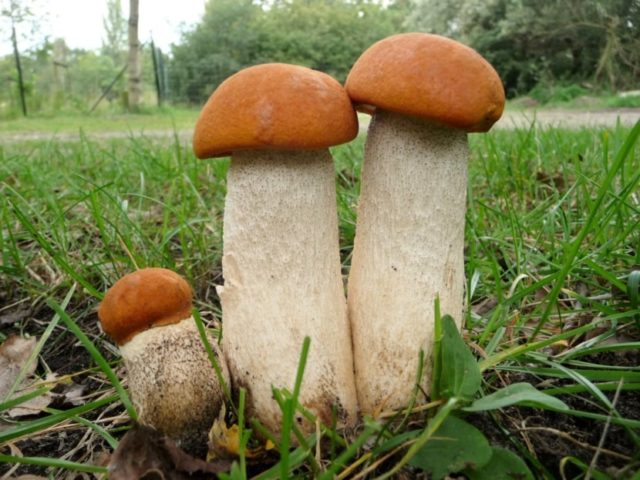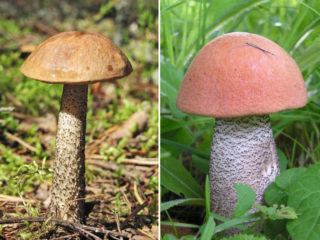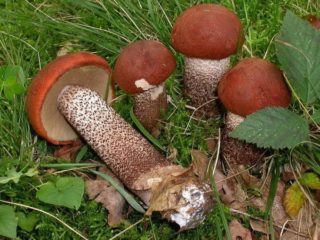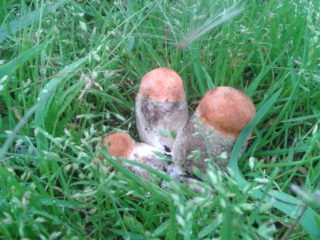Content
The fact that it is necessary to look for boletus in places where aspen grows has been known for a long time. This, in particular, is indicated by the name of the mushroom. It is also known as redhead, red mushroom, aspen mushroom, multi-skinned mushroom, red mushroom, red mushroom.
Boletus is classified as a group of elite mushrooms due to its exquisite taste and bright nutty aroma. The cap of the redhead can have different colors depending on the amount of sunlight it receives and the moisture it receives. Boletus grows, like many other mushrooms, only at certain times and in places suitable for it.
Where do aspen mushrooms grow?
Boletuses (pictured) grow in almost any forest. They can be found both in aspen forests and in mixed plantings - coniferous or deciduous. It is unlikely that you will be able to find redheads in a pure spruce forest.During hot and dry periods, they most often grow in young aspen groves.
Redheads can choose absolutely any place for themselves. Most of all they like forest areas protected from direct sunlight and blown by light warm winds. They love wet lowlands, shady bushes, woodlands overgrown with various grasses or moss.
Boletus is a name given to a whole group of mushrooms belonging to the botanical family Boletaceae of the genus Leccinum. They differ mainly in the size and color of the cap. At the same time, different types of boletus grow only in places suitable for them.
Types of boletuses
All redheads are edible and have the same nutritional value, so it is often difficult for mushroom pickers to distinguish them. In order not to confuse boletus with other mushrooms during collection, you need to know what a particular variety looks like and study their distinctive features and characteristics.
The main representatives of the genus are considered to be white, red and yellow-brown redhead. Other species include pine, oak, paintedfoot and blackscale.
Red (Leccinum aurantiacum)
Main characteristics:
- The cap is red, red-brown, red-red or orange.
- Leg height – 5-17 (20) cm.
- Thickness – 1.2-2.6 (6) cm.
- Cap diameter – 5-20 (30) cm.
It is found in the forest zone of Eurasia, in the northwestern and European parts of Russia, in Siberia, the Urals, the Caucasus, and the Far East.
Yellow-brown (Leccinum versipelle)
The mushroom cap is yellow with a brown or orange tint. Leg height – 7-23 cm. Thickness – 1.5-4 (7) cm.
Grows in northern regions with a temperate continental climate. In the European part of Russia, in the Far East.In lowland birch, aspen, spruce-birch and pine-birch forests.
White (Leccinum percandidum)
The cap of the species is white, gray-brown, its diameter is 4-16 (25) cm. The height of the stem is 4-10 (15) cm, thickness is 1.2-3 (7) cm.
A rare species found in Moscow and the Moscow region, in Siberia, Chuvashia, Western Europe, North America, and the Baltic countries.
Painted foot (Leccinum chromape)
Pink hat. Pink and red scales cover the entire surface of the leg. It is white-pink at the top, yellowish at the bottom. Distributed in East Asian and North American countries.
Pine (Leccinum vulpinum)
The hat is velvety to the touch, red-brown with a crimson tint. Leg height – 10-15 cm, thickness – 2-5 cm. Cap diameter – 15 cm or more.
Grows in European countries with temperate climates.
Oak (Leccinum quercinum)
Red or orange cap. Leg height – up to 15 cm, thickness – 1.5-3 cm. Cap diameter – 8-15 cm.
Has some similarities with boletus. Partner tree - oak. Grows in northern latitudes with temperate climates.
Blackscale (Leccinum atrostipiatum)
The cap comes in a variety of colors, from deep red to red-orange to terracotta red. Leg height – 8-13 cm, thickness – 2-4 cm. Cap diameter – 5-15 cm.
Grows in oak groves and mixed plantings of the northern regions.
Why do boletuses grow under aspen trees?
The boletus got its name due to the similarity of the color of the cap with the color of the autumn leaves of the aspen, as well as because of its close symbiosis with it.At its core, the redhead is a parasite. The mycelium penetrates the root system of the tree, thereby forming a special adhesion called mycorrhiza. Thus, an exchange process occurs between them. The boletus receives from aspen the organic substances necessary for full development and growth. In return, the mushroom gives the partner tree water and minerals.
This mutual exchange has a beneficial effect on redheads. Therefore, most often you can find boletuses in the forest under aspen trees.
When do aspen boletuses grow?
The growth of redheads occurs in layers or periods, like many other mushrooms. The first single specimens appear already at the beginning of summer, but boletuses begin to grow en masse a little later - in July. Mushroom growth continues until autumn, until the onset of the first frost.
But redheads do not grow constantly, but with breaks for rest. The duration of the mushroom layer depends on the amount of precipitation and temperature conditions. The most intensive growth of mushrooms is observed in September.
The collection time for boletuses extends over a long period of time. At the same time, the first mushrooms are called differently, depending on the time of appearance:
- Kolosoviki. They appear during haymaking and during the heading of winter grain crops.
- Zhnivniki. They begin to grow during the harvest season.
- Deciduous plants. Appear in early autumn.
Between layers and after, a rare single appearance of mushrooms is possible. This is often observed during the humid summer period, when fruiting is not very pronounced at times.
Variety of mushrooms | Fruiting dates | Peculiarities |
Spike boletus (white and yellow-brown boletus) | End of June and first half of July | Fruiting is not too abundant |
Reaper (oak boletus, red boletus and black scale boletus) | Second half of July or August-September | Productivity is very high |
Deciduous plants (spruce and red pine) | Second ten days of September and end of October | Long fruiting period right up to frost |
At what temperature do aspen mushrooms grow?
For the growth and full development of the mycelium, a temperature of 12 to 22 ° C is required, with a constant flow of fresh air. It lies approximately at a depth of 6-10 cm from the top layer of the earth. The boletus mycelium is perennial. It has excellent adaptability to changes in temperature conditions, so it can tolerate both drought and heat, as well as severe frosts.
In the absence of rain for a long time, the mycelium freezes and stops forming a mushroom body. Low temperatures also have a negative effect on mycelium growth. Rapid growth of boletus occurs with sufficient moisture and heat. The key to a good mushroom harvest is frequent, but not prolonged rains and moderate air temperatures. The optimal temperature is 18-20 °C.
How long does the boletus grow?
Fungal growth begins as soon as the mycelium is fully developed.The boletus grows on average from 3 to 6 days, and the mushroom reaches medium size. Under optimal growing conditions, it grows to 10-12 cm in 5 days. The boletus stem stops developing 1-2 days earlier than the cap, which then grows only in width.
At the beginning of autumn, during the long rainy season, the boletus grows quite quickly, increasing by several centimeters within 24 hours. Full maturity of the fungus occurs 7 days after emergence from the soil.
As quickly as redheads grow, they deteriorate just as quickly. Their life cycle lasts about 2 weeks.
Where to collect boletuses
Experienced mushroom pickers say that it is best to look for boletuses in a mixed forest, where aspen trees coexist with birch, oak, and pine trees. Collecting mushrooms is quite simple, since they have a noticeable bright appearance, and they do not hide, but grow in plain sight. But sometimes in dense forests, boletuses are found under piles of leaves. Therefore, in the fall it is easiest to find them in coniferous plantations. Handsome redheads can be seen from afar, even in dense grassy thickets and among fallen leaves.
Boletuses do not really like loneliness, so they often grow up in large families. You can find them along aspen, birch and alder plantings. Boletuses often prefer shady thickets of pure and mixed forests, shrubs, edges overgrown with moss, ferns, grass, and blueberries. Sometimes they can even be found in swamps. Depending on the species, the redhead chooses 1-2 trees as partners.
Types of boletuses | In which forest to collect | Preferred growing location |
Red | In deciduous small forest (pure and mixed), young aspen growth. In a dry summer in damp tall aspen trees | In the grass, in clearings and on the sides of forest roads, under young trees |
White | In wet birch and mixed | Any wet areas of the forest |
Yellow-brown | Pine-birch, birch, aspen and mixed | On rocky, sandy and peaty soils, under fern leaves |
17
Mushroom pickers going on a mushroom hunt in the forest should watch a video that tells how to look for and correctly collect boletus mushrooms:
Conclusion
The boletus grows in the summer-autumn mushroom season, delighting lovers of quiet hunting with its beauty. Under favorable weather conditions, the harvest can be quite large. The main thing is to know where boletuses grow and how to collect them correctly. Redheads are very highly valued by experienced mushroom pickers, second only slightly to the “king of mushrooms”, boletus. They are loved for their rich, original taste and ease of preparation. Boletuses are prepared in a variety of ways - fried, salted, canned and dried.
























